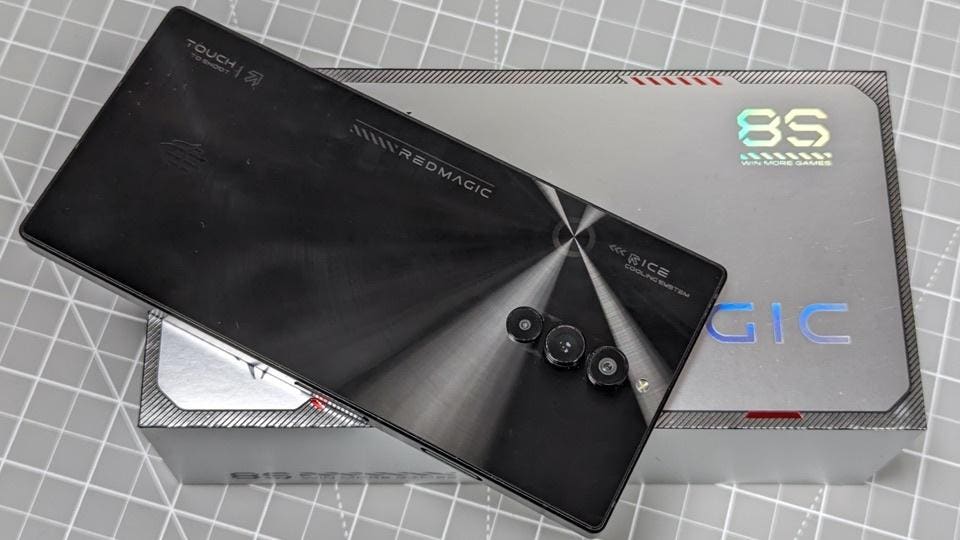Nubia’s Redmagic 8S Pro is a mid-cycle update to the impressive Redmagic 8 Pro powerhouse gaming smartphone. It’s broadly the same as the 8 Pro in terms of physical size (just 0.6 mm thicker) and some of the key features – such as the 120 Hz screen with an under-screen selfie camera, 6000 mAh battery, and the same 65W wired fast charge – have all carried over.
But can it deliver on a different gaming experience? Can it retro as much as modern?
The lack of waterproofing also carries over from the older, but that’s a design choice many gaming phones have to make. High-performance smartphones designed for gaming need to dissipate a lot of heat and dissipate it quickly. You have an active cooling fan to move air through the chassis and over the internals, and that’s not compatible with a sealed unit.
Cooling is one of the areas where the Redmagic 8S Pro has been redesigned. The air ducts have been redirected, the heat pipes use a new cooling gel that transfers heat more efficiently, a larger vapour chamber covers the battery and a new graphene layer has been placed under the display. All work to get the heat out of the casing and out in a way that keeps the handset’s surface from getting uncomfortably hot.
It also picks up Qualcomm’s refresh to the “leading” version of the Snapdragon 8 Gen 2, essentially overclocking the chipset up to 3.36 GHz. It also has the Red Core 2 gaming processor – this handles many gaming-specific features (including inputs from the shoulder keys, activating the vibration motors, RGB lighting, stereo effects, and more), leaving the System on Chip to handle the more mundane needs of a smartphone.
Given the above, after a quick check that the games that worked well on the 8 Pro work just as well, if not slightly better on the 8S Pro, I decided to give the Redmagic 8S Pro a different kind of workout. How well would it handle retro gaming and the titles I grew up with from previous decades?
Emulation can be an unforgiving environment. Not only are developers working to replicate the exact performance of one system on another, but they also have to contend with providing an additional UI layer to control the emulator itself – think of changing the frame rates, deciding which version of the hardware, loading up games originally shipped on cassette tape or ROM cartridge, and interfacing cleanly with the smartphone environment.
While the performance issues might be less of a worry on older 8-bit systems from the eighties, such as the ZX Spectrum, a smartphone is a long way from the qwerty keyboard-based environment with a digital joystick running through an RS232 serial port. Move up to more recent systems, and you have to deliver on the experience of a Nintendo 3DS while keeping frame rates high and the game speed matching the original.
The Redmagic 8S Pro will get some help here in the shape of a third-party controller. The company does offer its own gamepad in the Redmagic Shadow Blade Gamepad, but that wasn’t included with my review unit. Instead, I’ll be using two controllers I have to hand. The first is the Razer Kishi; which splits in half and clips to either end of the screen (in a similar way to the Shadow Blade), offering an all-in-one console-styled device… albeit one that is incredibly wide.
The second controller is the SN30 Bluetooth gamepad from 8BitDo. This doesn’t attach to the machine but offers a classic retro-styled gamepad with a modern control layout of two analogue sticks, a d-pad, four action buttons, and some shoulder triggers. The Kishi feels right for emulating the more recent games, while the SN30 is much closer to the games from the 80s and 90s.
Both controllers are picked up and recognised by the 8S Pro with no complaints, one via the USB-C port and one by Bluetooth. It takes a bit longer to map the controllers to the games I want to play, but that’s down to the apps I’m using; Android on the Redmagic 8S Pro does everything it needs to do to connect and pass on the inputs quickly.
In terms of software, I’ve been using RetroArch, PPSSPP, and Citra for the last month to cover three different eras of emulation.
Retroarch is a very mature multi-platform emulation system that covers almost the entire history of video games to varying degrees. It provides the UI layer and all the hooks into Android, while each emulator is represented by a separate “core” that you download from within the app or from external sources. I tend to use Retroarch for older systems. As with all emulation, you now have a ‘bare’ system that requires games to be sourced either from ripping and moving over your own content or heading to darker corners of the internet to find these mysterious ROM images.
I’ll highlight Chase HQ on the ZX Spectrum as a great example of running these older titles. It is acknowledged as one of the greatest titles on the platform that pushes everything to its limit. That means an old hand like me is very familiar with how fast the game should run, how responsive it is, and how it should look on screen. We can exclaim, “Let’s Go Mr Driver,” as Chase HQ passed with flying colours.
Next up on this whistle-stop check-in is with the Sony PlayStation Portable emulation. Again, an open-source and mature client is available for Android (and also Windows in the shape of PPSSPP. Things start to get more taxing now, and the Redmagic 8S Pro came through comfortably, even allowing for the upscaling and texture filtering options to run without any material impact on the gameplay. Boosting the visuals to modern standards may not be for the “pure emulation” crew, but the simple addition of the FXAA anti-aliasing post-processing is beautiful.
And again, all the extra performance the 8S Pro can provide means you can set up the emulator to your personal preference without worrying too much about the phone’s capabilities.
As you move into the modern systems, the difficulty of emulation starts to become apparent. Citra is a Nintendo 3DS emulator and delivers the dual-screened gaming device to a single touchscreen smartphone (you have various options to display the two screens and can choose which works best). At this point, emulation on Android starts to reach its limits. Where settings on PPSSPP and the older Retroarch cores could be applied without worry, emulating the Nintendo 3DS requires you to play around and decide what is essential.
Would you prefer to have an accurate frame rate? Perfect sound? Spot on graphics? The Redmagic 8S Pro’s specs will not let you have everything you want.
This is where Nubia’s focus on gaming performance becomes a benefit. The 8S Pro has more performance on tap than most Android smartphones. When you compare the performance of Citra on the 8S Pro against the performance on a Galaxy S23 Plus, you can see the benefits of the extra performance that the 8S Pro can deliver on the gaming experience.
Personally, I pulled back on the audio to get a consistent frame rate!
The emulation I was looking for rarely asked the Redmagic 8S Pro for its full performance. When it did, it delivered a few caveats I could choose for myself. What is clear is the difference that a good control system can make in a game. Made for mobile games such as the ubiquitous Genshin Impact, the genre-defining Fortnite, or more casual titles such as Mighty Doom, have all worked hard to ensure that the control schemes work with primarily touchscreens and gyro sensors. When you move back in time, the on-screen controls do their best, but a physical controller is needed to reduce frustration and make for a more playable experience.
Which naturally adds to the cost. The Razer Kishi 2 controller is £99, the Redmagic Shadow Blade is £69, and the SN30 is £39. The two plug-in controllers offer a traditional mobile gaming experience, allowing the Redmagic 8S Pro to feel more like a console than a smartphone. The SN30 offers a deep retro experience, but you must set your phone down somewhere to leave both hands free for the controller.
Just as you would when deciding between Xbox, Playstation and Switch, you need to determine what you will be using your gaming smartphone for. As the Redmagic 8 Pro proved earlier in the year, as a platform for the best native Android gaming titles, it delivers an impressive value for money experience. If you’re looking for something to explore gaming history with (as well as all the utility of an Android smartphone in the background), then the Redmagic 8S Pro has the power and flexibility to deliver on that goal as well.
Disclaimer: Nubia PR provided a Redmagic 8S Pro for review purposes.
Now read the latest smartphone headlines in Forbes’ weekly Android Circuit news digest…
Read the full article here








